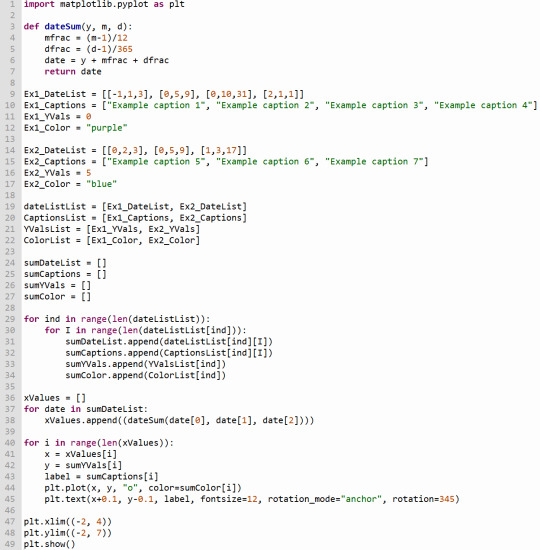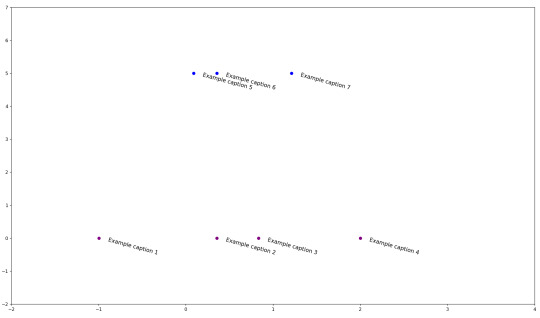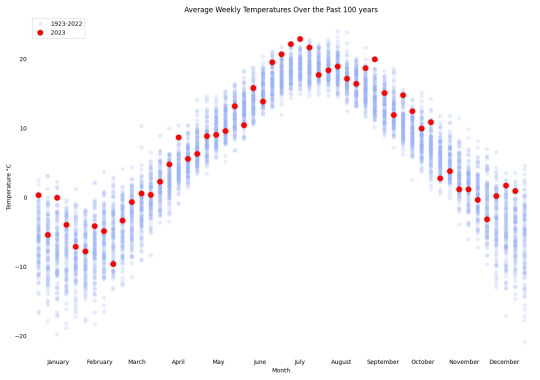#and Matplotlib
Explore tagged Tumblr posts
Text
Pandas, NumPy, and Matplotlib are three powerful Python libraries essential for data analysis. Pandas provides high-performance data structures like DataFrames and Series for data manipulation and analysis. NumPy offers efficient numerical computations with multi-dimensional arrays, enabling mathematical operations on large datasets.
0 notes
Text
Making a Digital Visual Timeline (in Python)
I have been on the hunt for a digital timeline I could easily use to store pivotal dates on and see the distance between them, as well as keep track of which events are in which story. And ultimately, I couldn't find a single website that satisfied me, so I made my own program. And swag bitches don't gatekeep, so I'm sharing how I made my timeline, in case anyone is running into the same struggles.
All you need to get started is any sort of program where you can write in Python (I use Thonny but anything that runs Python 3.10 works), and then import the Matplotlib library. If you use Thonny, this video tutorial is super short and straightforward. If you use something else, no doubt there are other video tutorials on how to import libraries on your given platform.
Then, copy in this code, making sure not to miss any indents or capitalization. I wanted to copy-paste the code directly into the text, but Tumblr doesn't register indents, so you have to copy from an image, sorry.

If you run this code as is, you should get this scatterplot.

Under the cut is further explanation of the parts you can and should change in order to make the timeline your own.

The Dates in the square brackets [] on lines 9 and 14 are formatted as Year/Month/Day. So if I wanted to make a point on September 2, 2009, I'd write it as [2009, 9, 2]. Each date must be enclosed in its own square bracket and separated by a comma.
The captions on lines 10 and 15 can be whatever you want, just keep them in quotations, and keep each quote separated by a comma. I like writing the date on the caption as well just for ease of reading.
Importantly, the number of Dates in any group's DateList line has to be equal to the number of Captions in the Captions line, but there can be a different number of Dates and Captions between groups. (So like, Ex1's DateList and Captions both have 4 items, but Ex2's DateList and Captions both have 3 instead.)
The YVals on lines 11 and 16 can be any number (though keeping the numbers relatively low, like from -5 to 5, is better). These just determine how high or low the dots appear on the timeline, if you want to keep different plots visually separate.
There is a LOT of freedom of choice for colors (lines 12 and 17) in Matplotlib. I recommend using the CSS colors, because you just have to write the name in quotations.
You can make more than 2 groups, and you can change the names of the groups. But if you do, you have to also adjust this part of the code below:

Whatever you name your Ex1 and Ex2 lists, put them into here. Additionally, you have to keep the lists consistent. If for example, dateListList was [Ex1_DateList, Ex2_DateList] and CaptionsList was [Ex2_Captions, Ex1_Captions], the code will either encounter an error or graph the wrong captions to the wrong dates.
Lastly, you can edit what parts of the graph appears using these 2 lines to control the X-axis and Y-axis of the plots respectively. You have to keep both pairs of parentheses for each line.

These numbers are relatively small because I chose small numbers as the example Dates. When I use this code for myself, I often switch between a view of (1950, 2050) to see roughly everything in the modern era, or (400, 2400) if I want to see some of the older historical events I've included as well.
These are just the parameters you HAVE to adjust to actually control your own timeline. You can ABSOLUTELY do more if you want to (just make sure to save backups :P). And if you have any questions, feel free to ask!
Happy timelineing!
#leah speaks :3#writblr#writerblr#timeline#timeline maker#writing resources#coding#compsci#python#matplotlib#i normally don't do heavy tags like this but SWAG BITCHES DON'T GATEKEEP! I wanna share this so nobody else has to struggle like I did!
10 notes
·
View notes
Text
I wish my Python code would make a "ding!" sound when it's done rendering. I want to be able to return to a machine learning model the same way that a housewife would return to the oven. I need an egg timer for when the computer is done thinking.
8 notes
·
View notes
Text

Unraveling Threads
4 notes
·
View notes
Text



I've been thinking about climate data again. We have records here going back over 100 years. I thought I'd see how this past year compared to the previous 100. Interesting to see the different grouping intervals.
22 notes
·
View notes
Text
spiking neural networks
writing up some code in rust and python to replicate basic eeg activity using spiking neural networks

it uses a lattice of leaky integrate and fire models to act as biological neurons
unlike a classical neural network, this system has a sense of time
on the right you can see the voltage of the membrane potential of each neuron change over time
on the left you can see the concentration of signaling neurotransmitters in each neuronal synapse that contribute to how the membrane potential changes over time
extremely basic modeling but it looks neat
(neuronal calcuations done in rust, visualization in python and matplotlib)
29 notes
·
View notes
Text
Python for Data Science: From Beginner to Expert – A Complete Guide!
Python has become the go-to language for data science, thanks to its flexibility, powerful libraries, and strong community support. In this video, we’ll explore why Python is the best choice for data scientists and how you can master it—from setting up your environment to advanced machine learning techniques.
🔹 What You'll Learn:
✅ Why Python is essential for data science
✅ Setting up Python and key libraries (NumPy, Pandas, Matplotlib) ✅ Data wrangling, visualization, and transformation
✅ Building machine learning models with Scikit-learn
✅ Best practices to enhance your data science workflow 🚀 Whether you're a beginner or looking to refine your skills, this guide will help you level up in data science with Python. 📌 Don’t forget to like, subscribe, and hit the notification bell for more data science and Python content!
youtube
#python#datascience#machinelearning#ai#bigdata#deeplearning#technology#programming#coding#developer#pythonprogramming#pandas#numpy#matplotlib#datavisualization#ml#analytics#automation#artificialintelligence#datascientist#dataanalytics#Youtube
3 notes
·
View notes
Text
i just spent the morning coding in python for pretty much the first time in a year. oh how i missed you my beloved
#i speak#the most ive done since last july has been making a graph from an excel sheet with matplotlib 😭#luckily next year i have a lab based course so ill get to code all year long ^-^
4 notes
·
View notes
Note
hi happy february!
i am interested in knowing what a few of you favorite words are at the moment. for science!
hap february!
favourite words isn't a thing that i generally think about that often? so if i'm asked again in future i can't guarantee consistency, but no particular order here either
girasol - a type of opal and my go-to player name if i don't have a better option and cruithne is too long. the earliest i remember using it is for a silver dragon's light spirit companion probably like 15 years ago at this point?
citadel - i don't know why, but it's a cool word and i really want to use it for a character name. possibly because i was a darigan citadel stan back on neopets but
materwelon - it's just watermelon with letters reversed and it lives in my head rent free
similarly, strawbebby / strawbebbies from one of the many ranibow sprimkle threads
more of a prefix, but demi- just fits a lot of stuff i vibe with
malina - polish for raspberry, it's one of the few polish words i actually remember and can pronounce (i think)
renegade - oops giratina moment
there's a lot of words fighting for attention but that's probably all i can squeeze some actual explanation from, but - i hope this data helps your science :)
#also saying perihelion would be too obvious. i mean what#bonus joke disliked 'word': the python module matplotlib because the dyspraxia hecks me up and i can't say it
4 notes
·
View notes
Text
every time i try to put a god damned legend on this graph with seven lines on it my laptop literally freezes for minutes at a time so i can only click one thing before it goes non-responsive again. which is pretty much a great summary of how this stupid capstone project is going.
#i hate microsoft excel so much#science side of tumblr help me. i’m graphing UV spectra. i need several spectra on one graph. my python is not working for some reason#i mean it won’t open a new notebook. otherwise i would use matplotlib#i don’t know anything else. is there any software i can use#i’m sorry i’m very young and stupid i don’t know why i’m going for a phd either
5 notes
·
View notes
Text
yes i installed python on 3 different occasions and uninstalled parts of it multiple times. I have only one version though, and that version is Unwell
#txt#i didnt have pip and it couldn't see matplotlib for so long my teacher thought it was unfixable without reinstalling the whole thing#again#ughhh
1 note
·
View note
Text
Top 10 Python libraries for 2025

Top 10 Python Libraries You Should Master in 2025
Python has remained one of the top programming languages over the years because of its ease, adaptability, and large community. In 2025, Python is still the leading language across different fields, ranging from web design to data science and machine learning. To be competitive and productive in your Python projects, mastering the correct libraries is critical. Here's a list of the top 10 Python libraries you should learn in 2025 to level up your coding game. 1. TensorFlow Use Case: Machine Learning & Deep Learning Overview: TensorFlow, created by Google, is one of the leading machine learning and deep learning libraries. It's utilized for creating and training deep neural networks and is extensively used in many applications like image recognition, natural language processing, and autonomous systems. Why Master It? With the advent of AI and deep learning in 2025, TensorFlow is a library that must be mastered. It's extremely flexible, accommodates scalable machine learning tasks, and enjoys strong community support and tutorials. 2. Pandas Use Case: Data Manipulation & Analysis Overview: Pandas is a must-have library for data manipulation and analysis. It offers robust tools for data cleaning, analysis, and visualization through its DataFrame and Series data structures. It integrates perfectly with data from various sources such as CSV, Excel, SQL databases, and others. Why Master It? Data analytics and science remain key areas in 2025. Pandas is central to data wrangling and analysis and, thus, a must-have tool for anyone handling data. 3. Flask Use Case: Web Development (Micro-Framework) Overview: Flask is a simple, lightweight web framework in Python used for quick and efficient development of web applications. It's bare-bones, having flexibility for developers who desire greater control over their applications. Why Master It? Flask will still be a favorite for microservices and APIs in 2025. It's ideal for those who like the modular way of developing applications, so it's great for fast and scalable web development. 4. NumPy Use Case: Scientific Computing & Numerical Analysis Overview: NumPy is the backbone of numerical computing in Python. It supports large multi-dimensional arrays and matrices and has an enormous library of high-level mathematical functions to work on these arrays. Why Master It? In 2025, numerical computing will still be critical to data science, finance, machine learning, and engineering tasks. NumPy mastering is vital to efficient mathematical operations and data manipulation in scientific computing. 5. PyTorch Use Case: Machine Learning & Deep Learning Overview: PyTorch is a deep learning framework created by Facebook's AI Research lab and has quickly become popular because it is flexible, easy to use, and has a large community of developers. It's utilized for creating sophisticated neural networks and is also famous for having a dynamic computation graph. Why Master It? PyTorch is a top pick for machine learning practitioners in 2025, particularly for research and experimentation. It's simple yet powerful, and that makes it a great fit for leading-edge AI development. 6. Matplotlib Use Case: Data Visualization Overview: Matplotlib is the first choice library to create static, animated, and interactive visualizations in Python. It's applied for plotting data, graph creation, and chart construction that facilitates making sense of big datasets. Why Master It? Data visualization is crucial to the interpretation and representation of insights. Learning Matplotlib will enable you to effectively communicate your data discoveries, making it an essential for data analysts, scientists, and anyone who works with data in 2025. 7. Scikit-learn Use Case: Machine Learning Overview: Scikit-learn is among the most widely used machine learning libraries, providing simple-to-use tools for classification, regression, clustering, and dimensionality reduction. It can handle both supervised and unsupervised learning and is compatible with other scientific libraries such as NumPy and SciPy. Why Master It? In 2025, Scikit-learn continues to be a robust, easy-to-use library for creating and deploying machine learning models. Its simplicity and thoroughly documented functionality make it perfect for both beginners and experts in data science and machine learning. 8. Keras Use Case: Deep Learning Overview: Keras is an open source library that is an interface for TensorFlow, enabling users to make deep learning model creation and training more convenient. Keras uses a high-level API that allows it to design neural networks and sophisticated models without complexities. Why Master It With the increased significance of deep learning, Keras will be a go-to choice in 2025. It makes designing neural networks easier and is a great tool for those who need to prototype deep learning models very quickly without delving into difficult code. 9. Django Use Case: Web Development (Full-Stack Framework) Overview: Django is a Python web framework for rapid development and clean, pragmatic design. It also has built-in features such as authentication, an admin interface, and an ORM (Object-Relational Mapping) that make it suitable for developing strong web applications. Why Master It? In 2025, Django remains a top choice among frameworks for creating scalable, secure, and easy-to-maintain web applications. To work in full-stack web development, you must be proficient in Django. 10. Seaborn Use Case: Data Visualization Overview: Seaborn is a Python data visualization library based on Matplotlib. Seaborn simplifies the development of attractive and informative statistical visualizations. Seaborn gives a high-level interface for making beautiful and informative data visualizations. Why Master It? Seaborn will still be useful in 2025 for people working on depicting sophisticated statistical data. It is ideal for data analysis due to its inclusion with Pandas and NumPy, and rich color palettes and styles will make your plots look more visually appealing. Conclusion As we enter 2025, these top 10 Python libraries—spanning from AI and machine learning libraries such as TensorFlow and PyTorch to web frameworks such as Flask and Django—will inform the future of software development, data science, AI, and web applications. Regardless of your level of expertise—beginner or experienced Python developer—becoming a master of these libraries will give you the knowledge necessary to remain competitive and effective in the modern tech world. Read the full article
#DeepLearning#Django#Flask#Keras#MachineLearning#Matplotlib#NaturalLanguageProcessing#NumPy#Pandas#PyTorch#Scikit-learn#Seaborn#TensorFlow
0 notes
Video
youtube
How To Install Matplotlib In Windows
0 notes
Text
I (physics student) just helped my computer science student friend with her coding????
#she hates python and python is the only coding language i know lmao#even better shes using it to make graphs which is like the number one thing im good at. matplotlib my beloved
0 notes
Text

I was wondering about shutter speed and aperture combinations for my 4 lenses.
7 notes
·
View notes
Text

Guys,
Does it look like a t-shirt pattern?
1 note
·
View note